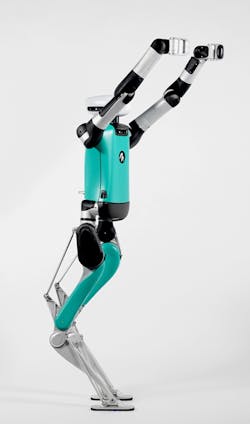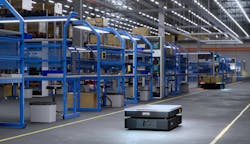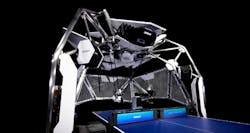This year, the International Symposium of Robotics (ISR) has been organized in conjunction with Automate (May 22-25, 2023). It’s a bonus for roboticists, suppliers and end-users alike, since attendees can take full advantage of integrated conference sessions.
The annual gathering in Detroit is organized by A3 (Association for Advancing Automation) and will focus on how operational robots are impacting the manufacturing world.
Globally, the stock of operational robots now tallies 3.5 million and holds an estimated installation value of $15.7 billion, according to the International Federation of Robotics. Behind these figures are advances in robotics that propel the connected digital ecosystem.
Foremost are the rise of solutions that pair user-friendly software with intuitive user experience, according to IFR reports. This means OEMs can work in tandem with low code (and no-code) partners in setting up easy-to-use programming interfaces. The pairing will effectively make it easier, for example, to equip traditional heavyweight industrial robots with sensors and software to facilitate collaborative setup operation.
Machine Design will be on the Automate trade show floor attending briefings and scoping out macro trends, such as the increasing role AI plays in robotics and how manufacturers use it to save costs through responsible use of resources.
Meanwhile, the news and technology updates that follow below can offer a sampling of robotic automation and R&D that are opening up a host of opportunities in the here-and-now.
Highly Automated Facility Manufacturing Next-Gen Robots
Electrification and automation leader ABB reported that close to 90% of its robots geared for the U.S., Canada, Mexico and South America, will soon be made in Auburn Hills, Mich.
An expansion of ABB’s existing North American robotics headquarters and manufacturing facility in Auburn Hills will supplement the $14 billion sum already invested in the U.S. since 2010. The project is expected to benefit growth sectors, such as electric vehicles, healthcare, packaging and logistics, and “responds to the increased demand for automation from 70% of U.S. businesses looking to bring production closer to home,” noted an ABB Robotics survey.
ABB stated in a press release that the plant will employ flexible, modular production cells that are digitally connected and networked, and served by intelligent autonomous mobile robots. AI-powered robotic systems will take on tasks such as screw driving, assembling and material handling. The project, representing an investment of $20 million, is expected to be completed in November 2023.
Intralogistics Robot with a Human Form Factor
Agility Robots unveiled the next generation of Digit, a bi-pedal, multi-purpose robot made for picking and placing, at ProMat 2023 in Chicago (March 20-23, 2023). A key feature related to a robot with human form factors is its ability to fit into and navigate spaces designed for people. In existing warehouse operations and as-built infrastructure, this could mean deployment without costly retrofitting. A fleet of Digits could foreseeably switch between applications and take on dirty and dangerous tasks, depending on warehouse needs and seasonal shifts.
The latest generation of Digit includes newly designed end effectors optimized for grabbing and moving plastic totes commonly found in warehousing. Standing tall at 5-9 and weighing in at 141 lb., Digit’s appendages are designed with 20 actuators that enable the robot to almost fully collapse its legs and maneuver its bodyweight back and forth. A head and eyes have been added to improve human-robot interaction. Digit’s optimized runtime is 16 hours, and it can connect itself to a docking station when it needs to charge.
Agility Robotics is inviting companies to apply to deploy Digit in their warehouses by applying to Agility Partner Program before it is commercially available. The working relationship will help train and improve the robots in workflows and operations.
Digit is multi-purpose, so it can execute a variety of tasks and adapt to many different workflows.
Autonomous Mobile Robot Handles Heavy Loads
OTTO Motors, a provider of autonomous mobile robots, is building on its material handling portfolio with the release of the mid-range AMR, OTTO 600. Complete with an all-metal, rugged construction and IP54 rating, this AMR can move pallets, carts and other payloads up to 1,322 lb and can move at a maximum speed of 4.5 mph.
The AMR also benefits from OTTO’s latest software release, 2.28. According to the company, the software not only has a new facility configuration interface for quicker workflow setup, but also upgrades the traffic management functionality, so that users may create different rules of the road for groups of different OTTO AMRs in a facility. OTTO also supports the AGV standard, VDA5050, which allows customers to manage dissimilar types of material handling solutions from a third-party master controller interface.
Cobot and AMR Collaboration
Picking, packing and screwdriving are among the laborious tasks that plants can now delegate. OMRON’s collaborative robot performs a palletizing operation together with the LD-250 250kg payload autonomous mobile robot (AMR). The TM series of cobots are equipped with various vision functionalities that enable safe, flexible engagement between human and machine.
OMRON also released a “mobile-compatible” model, which seamlessly integrates into OMRON’s LD series autonomous mobile robot. This raises the level of complexity to where the robot can pick and place onto a tray or container, as well as to connect processes with autonomous mobile robots.
Harmonized Automation
Omron’s showstopper at Hannover Messe 2023 will be an application based on the evolution of the industry-renowned FORPHEUS AI-based table tennis robot.
The demonstration both elevates the concept of “harmonized automation” and points the way to a future where robots can help humans improve their skill sets, as well as their manufacturing and production processes.
OMRON paired a flexible assembly machine with AI-powered learning, by combining automation technologies such as robotics, control, sensing and vision with emerging technologies such as AI, AR and 5G.
Using OMRON’s core “Sensing & Control + Think” technology, the robot learns how to execute the assembly task by following the hand movements and learning from the human operator’s mistakes. The machine develops the optimal strategy for assembling the product. A digital twin of the robot is then created to train other operators in a virtual environment. The process enables continual performance improvement.
About the Author

Rehana Begg
Editor-in-Chief, Machine Design
As Machine Design’s content lead, Rehana Begg is tasked with elevating the voice of the design and multi-disciplinary engineer in the face of digital transformation and engineering innovation. Begg has more than 24 years of editorial experience and has spent the past decade in the trenches of industrial manufacturing, focusing on new technologies, manufacturing innovation and business. Her B2B career has taken her from corporate boardrooms to plant floors and underground mining stopes, covering everything from automation & IIoT, robotics, mechanical design and additive manufacturing to plant operations, maintenance, reliability and continuous improvement. Begg holds an MBA, a Master of Journalism degree, and a BA (Hons.) in Political Science. She is committed to lifelong learning and feeds her passion for innovation in publishing, transparent science and clear communication by attending relevant conferences and seminars/workshops.
Follow Rehana Begg via the following social media handles:
X: @rehanabegg
LinkedIn: @rehanabegg and @MachineDesign




